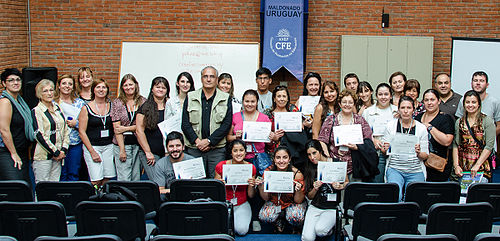Education/Newsletter/June 2014/Wikipedia Education Project in Uruguay

By Roxana Sordo (Proyecto Wikipedia en la Educación)
In Uruguay, the Wikipedia in Education Project (Proyecto Wikipedia en la Educación) is being led by Professor Fernando da Rosa and a team of four professors in Uruguay, who are members of Wikimedia Uruguay.
Consejo de Formación en Educación signed an agreement that Wikipedia editing would become a standard part of the curriculum for new teacher training. The project started in 2012. We gave presentations and workshops on Wikipedia editing in different teaching institutions all over the country and used an official website to communicate at Eduwiki.me. The main objective of the project is to generate a sense of technological ownership in teachers-to-be and professors by using Wikipedia in the teaching and learning processes.
The specific goals of the project include:
- to engage teaching professors in reflective processes about the educational use of Wikipedia according to their possibilities
- to create a small team of professors to work on theoretical, methodological and technical knowledge in order to develop digital competences related to Wikipedia
- to promote critical reading, collaborative work and the use of Wikipedia in the teaching and learning processes.
As a result of the project, over one hundred good-quality articles on education, lesson plans, academic knowledge, local culture and current affairs have been created by students and professors at CFE (Consejo de Formación en Educación), ANEP, Uruguay with the help of Plan Ceibal, a national organization which is based on the OLPC Program. Moreover, there have been annual national meetings with regional guests in order to share knowledge, teaching and learning experiences on Wikipedia.
Some of the Wikipedia articles created in Spanish in the project include:
- Floraciones algales
- Filosofía con niños
- Festival Minas y Abril
- Fuente del Toro
- Cerro Cementerio
- Refugio de fauna Laguna de Castillos
- Alán Gómez
Some Wikipedia articles in English created in the project include:
- Juan José Morosoli
- Santiago Chalar
- Uruguayan Carnival
- Flora of Uruguay
- Carnival Museum
- Andes Tragedy Museum

Even though the workshops were optional, more than 1,200 people took part in them, 70% students and 30% professors. Half of the participants are active Wikipedia users today and have categorized themselves as wikipedians from Uruguay.
Indeed, Wikipedia is one of the most popular web 2.0 tools in Uruguay and around the world. It appears as one of the first search results in web search engines. As a matter of fact, people frequently use Wikipedia to get informed, especially our students, by means of their cell phones, tablets, laptops, and personal computers.
When it comes to teaching linguistic and digital competences, some burning questions may come up. What teaching strategies are we actually using under these circumstances? How can we integrate new technologies with language teaching? How can we teach digital citizenship, especially digital literacy and digital responsibility?
What are students reading Wikipedia articles for?
Students read for different purposes: to be informed, to prepare a lesson, to study for a test or an exam, to research a topic, to look for information sources, to do an activity or a piece of homework and for pleasure. Knowing the reading purpose is crucial for students and teachers to know the most adequate reading strategies to use. When students do not know what they are reading for, in general, they feel clueless and they lack motivation. Teachers should take the reading purpose into account and help students identify it, so that they can approach a text and do reading activities adequately.

What writing strategies can we teach students by using Wikipedia?
Before students start writing, teachers can teach them how to plan the content and form of their texts, taking into consideration the audience they address, use graphic organizers in order to expand ideas, use background knowledge about a topic to look for information, read writing models, see similar Wikipedia articles, focus on spelling, writing codes and learn how to use punctuation. While students are writing, we can teach them how to monitor their work, apply learning styles, use lexical chunks and avoid excess use of a dictionary. Once students have written a Wikipedia article, we can teach them how to share their work so that others can read it and provide them with immediate feedback, check cohesion, spelling and cohesion, look for similarities and differences among information sources, categorizing articles, evaluating and discussing their work.
Some testimonials from students and professors on the project
"I reckon the work it takes to create a Wikipedia article has contributed to my knowledge about this software. Besides, it makes me wonder about the learning process, specifically in reference to knowledge production about a certain topic. I´m thinking about the possibility of creating an article that is going to be watched and edited by more experienced users. This is not a minor point since help is always welcome when learning."
—Loredana Parrillo, Teacher-to-be in Maldonado, Uruguay, User:Lore014
"In my opinion, Wikipedia is an internet asset to democracy. As I see it, it is a relevant tool because it contributes to a global culture and makes meaningful social practices possible, in general. It is about collaborative work, which is a great teaching practice. I created a Wikipedia article on Arrozal 33, a small town in Treinta y Tres, which is part of the historical heritage here and it was not part of this encyclopedia. I think my participation in Wikipedia was important and that is the essence of Wikipedia: to participate and collaborate to keep on creating and contributing”."
—Ignacio Senosiaín, Teacher-to-be in Treinta y Tres, Uruguay, User:Nachosenosiain
Additional documentation
See the entire article at: www.eduwiki.me